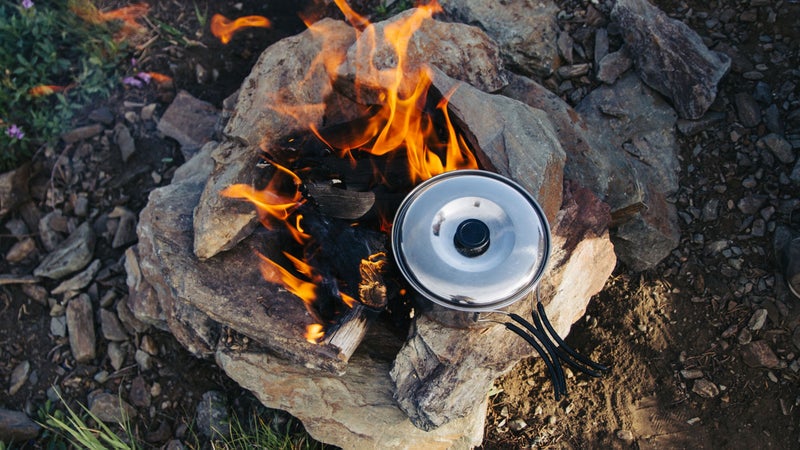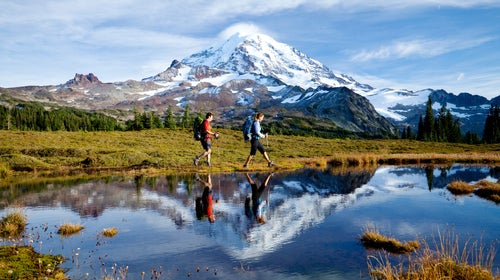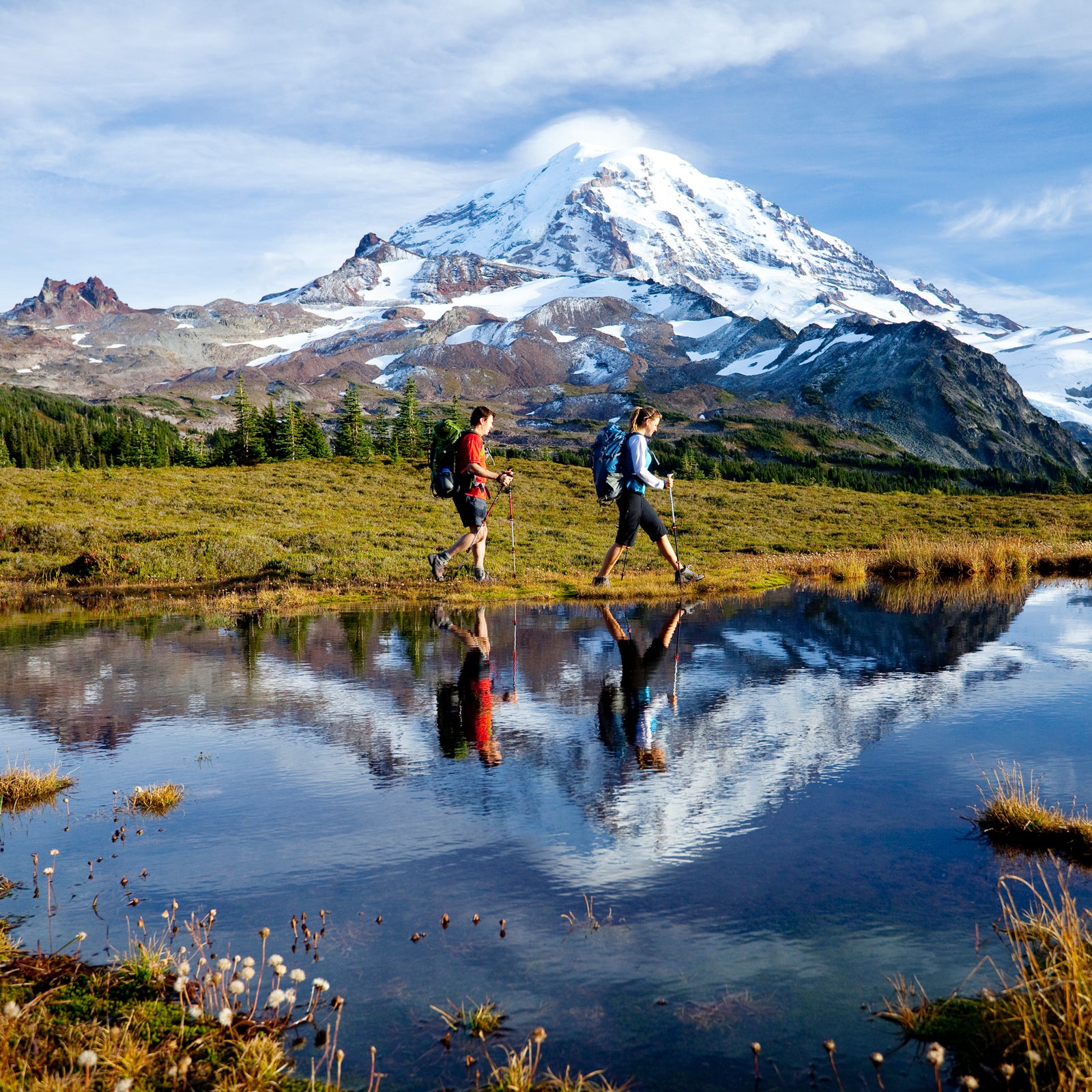Each year╠řabout 4,000 backpackers attempt thru-hikes on the nationÔÇÖs big three footpaths: the Appalachian, Pacific Crest, and Continental Divide Trails. Each is a massive commitment, with gear bills in the thousands of dollars and up to six months away from work.
But backpacking doesnÔÇÖt have to be a months-long, bank-account-draining undertaking. For many people, the real appeal of backpacking╠řis the quiet remoteness it affords, a╠řchance to step away from the rat race and experience some real solitude. With a little bit of planning and creative preparation, you can easily have the time of your life out there, even if this is your first overnight sojourn.
Safety First
As great as backpacking is, it also comes with certain risks. ItÔÇÖs your job to minimize them with some basic precautions:
- Assume that youÔÇÖre not going to have cell-phone reception for at least part of your hike. That means╠řif you get lost (and even the best hikers do), itÔÇÖs going to be up to you to get yourself found. Always make sure an emergency contact is aware of your intended itinerary, when you plan to return, what vehicle╠řyouÔÇÖll be driving, and who is going with you.
- Invest in a decent compass and of your hiking destination, and know how to use both. Many major gear outfitters and regional chapters of offer map and compass courses for new users that usually cost less than $100. If you canÔÇÖt get to one of these locations, check out the Appalachian Mountain ClubÔÇÖs or this video from REI.
- If you have the cash to spare, consider investing in╠řa personal locator beacon╠ř(usually a few╠řhundred dollars), which will allow you to send your exact location and/or an emergency distress call when thereÔÇÖs no cell reception.
- And be sure to study╠ř from the U.S. Forest╠řService on what to do if you do get lost or find yourself in distress: itÔÇÖs chock-full of great tips on how to keep it together when all else fails.
Keep It Simple
On the╠řTrail
State and national parks can be great places for beginners: their trails are usually well marked, and their websites offer user-friendly guidelines for new and experienced hikers alike. For first trips, , director of the Appalachian Trail Institute,╠řwho has been educating hikers for over 45 years, recommends staying close to home and restricting initial outings to easily accessible and well-indicated╠řtrails. Look for routes with low mileage╠řand little in the way of difficult terrain, like steep elevation gains and losses or╠řtricky footing that you might find╠řwith boulders, loose rock, or even a ratÔÇÖs nest of roots.╠řÔÇťBe modest in your expectations,ÔÇŁ Doyle advises. ÔÇťThis isnÔÇÖt about completing mileage. ItÔÇÖs about simplicity and the willingness to step away from societyÔÇÖs cradle. You can do that as easily in five miles as you can 500.ÔÇŁ Websites like and offer databases that can be searched by zip code or geography, and regional trail conservancies are also great resources.
Searching for a Campsite
ÔÇťDonÔÇÖt be afraid to set up camp after just a few miles on your first day, especially if youÔÇÖre already tired,ÔÇŁ Doyle says. Also consider╠řusing this camp as the╠řbase for your weekend adventures. For╠řweekend hikes, this might mean╠řhiking╠řin and establishing╠řa base camp on Friday night, which then allows╠řyou to day-hike on Saturday with a much smaller pack╠řand╠řreturn to your╠řtent and sleeping bag that evening. ThereÔÇÖs also no harm in using the hostel-hut systems at places like ╠řin California╠řor ╠řin New Hampshire. But╠řif you want the full backpacking experience, look for loops with designated camping areas or even established shelters (which often also come with water sources nearby).
Before You Buy
, author of ,╠řhiking record holder, and owner of the Blue Ridge Hiking Company, in Ashville, North Carolina, recommends using loaner hiking gear before investing in your own goods. ÔÇťItÔÇÖs hard to know what you need without a frame of reference,ÔÇŁ she says. ÔÇťBy borrowing or renting gear, you can decide what you love, like, dislike, or canÔÇÖt stand about certain products.ÔÇŁ╠řREI╠řrents out gear, including╠řbackpacks and╠řcamp stoves, but you should╠ř for a complete list╠řof available gear.╠řOr, for $92 per day, startup╠řCampCrate will mail you a , including a sleeping bag, tent, water filter, and headlamp.
The Essentials
Once youÔÇÖre ready to invest in your own╠řgear, you need to determine where and how youÔÇÖre going to regularly hikeÔÇödifferent climates and trip lengths╠řwill call for different gear. Backpacks come in a variety of sizes, and most are measured in liters; you can probably get away with a backpack in the 50-to-60-liter range for a trip less than four days. Many sleeping bags are labeled by the minimum temperature an average sleeper will be comfortable; a compressible 20-degree bag will work for╠řmany people for three seasons. And while some prefer crawling into a tent at night, others prefer to sleep in a bivy sack or hammock.
Other essential items include a basic first-aid kit, activity-specific items like sunscreen, bug spray, moleskin or duct table for blisters, and a Mylar emergency heat blanket (which can also serve as a great signal for search and rescue planes╠řin the event you get really lost). A reliable headlamp with fresh batteries is also a must, as is a whistle, a waterproof lighter or matches, and a collapsible knife or multitool.
For a comprehensive list of recommended equipment, check out the National Outdoor Leadership SchoolÔÇÖs basic or ║┌┴¤│ď╣¤═°ÔÇÖs list╠řof backpacking essentials.
Pack Right
When it comes to packing these essentials, play to the engineering of the pack itself. Modern-day backpacks are designed with waist belts that distribute the weight of a pack to your hips and lower body, where our real core strength lies. Keep heavy items, like reserve water, heating fuel, and food, low in the main pouch of the pack, and place light items, like a down coat or sleeping bag, higher in the back. The most essential items, like maps, snacks, a cell phone,╠řand at least one water bottle, should be kept in an external pocket where they can easily be reached.
Practice Makes Perfect
At DavisÔÇÖs store,╠řmornings are by appointment only so that backpackers can receive one-on-one attention from employees trained to help customers find the right size backpack and make sure itÔÇÖs properly fitted. Even if that kind of individualized treatment isnÔÇÖt available where you live, find an outfitter that will take the time to show you how to use items like a╠řwater purifier,╠řcamp stove, tent, and rain fly. Practice using them╠řlong before youÔÇÖve hit the road. ThereÔÇÖs nothing like getting stuck outside in a deluge to make you consider another hobby.
Hit the╠řGym Before the Trail
Even the most thoughtfully packed backpack is going to add extra weight and strain to your body. Couple that with the repetitive motion of hiking╠řand youÔÇÖre going to tax your body in new (and sometimes exhausting) ways.
To make sure that body is trail ready, personal trainer and competitive ultramarathoner recommends considering a workout strategy that leads with basic cardiovascular conditioning. ÔÇťBefore you even add weight to the mix, start spending some real time on your feet,ÔÇŁ Seaver says.
After that, youÔÇÖll╠řneed to train your body for the unique demands of hiking with specific exercises. Building core strength will help keep you stabilized on variable terrain; back and upper-body strength will help you shoulder that pack. To achieve both, Seaver recommends these five exercises.╠řTry for ten╠řreps of each, making sure to focus on controlled movement and good form.
Step-Ups
Lunges
Single-Leg Deadlifts
Downward-Dog Holds
Push-upsÔÇöRegular or Modified
Consider Your Fuel╠ř

When planning meals, think first about what and how you actually like to eat, and then add a little bit to that. Backcountry cooking can be a blast and even gourmetÔÇöbut only if you have the time and patience to pull it off. And although dehydrated meals are super easy, they are also expensive.
, a registered dietician and Appalachian Trail thru-hiker, recommends starting with easy enhancements to supermarket meals. For breakfast, sheÔÇÖll add peanut butter or Nutella to instant oatmeal and wash it down with an instant coffee. Lunches are almost always variations on wrapsÔÇöthere are endless combinations to be had with╠řhummus, a good hard cheese, and some salami. CarberryÔÇÖs preferred dinners start with boxed rice or╠řpasta (think AnnieÔÇÖs mac and cheese or Near EastÔÇÖs rice pilaf), to which sheÔÇÖll add pouches of tuna or precooked chicken. Umami goes a long way to making food taste great, so consider bringing along small bags of sun-dried tomatoes, olives, or freeze-dried mushrooms for some zing. Travel-size condiments like sriracha or flavored salts can add a welcome zip of flavor to the mix as well. ÔÇťItÔÇÖs a way less expensive way to eat,ÔÇŁ says Carberry, ÔÇťand youÔÇÖre still ultimately just boiling a pot of water.ÔÇŁ
Carberry advises╠řhikers putting in╠řlight to moderate effort╠řto╠řadd an extra 500 to 1,000 calories to their daily intake. Spreading out those calories with regular snacks is a great way to keep from bonking. Energy bars are easy, as is the omnipresent trail mix. And when it comes to hydration, Carberry says she tends to skip energy drinks or hydration powders in favor of water. ÔÇťIf youÔÇÖre drinking the recommended daily amountÔÇŁÔÇöat least 64 ounces, with more for cookingÔÇöÔÇťand eating adequately, hydration shouldnÔÇÖt be a problem,ÔÇŁ╠řshe says.
Take Only Photographs,╠řLeave Only Footprints
We take to the trail because it is wild and often pristine. But it doesnÔÇÖt take much to destroy that beauty altogether. ThatÔÇÖs one reason why backpacking is defined by ╠řethics,╠řand itÔÇÖs essential you know how to follow it.╠řHike only on designated paths. Whenever possible, camp only on designated sites. Light fires only in established fire rings (or even better, donÔÇÖt light one at all). Clean up every campsite before you leave, even if the trash isnÔÇÖt yours, and leave the rest of the ecosystem as╠řyou found it.
The Nitty-Gritty
With few exceptions, any trail should always be considered carry in, carry out.╠řThat includes obvious stuff like wrappers and empty canisters, but it also includes leftover food, water used for cleaning, toilet paper, and (letÔÇÖs just get this out there) your own poop. If the landscape allows for it, you can opt to bury your organic waste in a cathole, so long as it is at least six╠řinches deep and 200 feet away from any water source. If thatÔÇÖs not an option, youÔÇÖre going to need to invest in a ÔÇöthough╠řon more than one occasion, IÔÇÖve successfully used pet-store poo bags to surprisingly good ends. To avoid lugging excess stinky trash, many female hikers will use a dedicated pee rag (often a bandana kept in a Ziploc bag) and a menstrual cup. To further cut down on what you need to pack out, combine meal ingredients into single bags and favor bulk-food items, especially those that can be stashed in resealable pouches. Resealable freezer bags make for great garbage-disposal units on the trail.
If any of these rules feel confusing, stick to this basic mantra: the woods do not belong to me. If that doesnÔÇÖt work, try this one: I will not be a jackass. Got it? Good. Now get outside.














